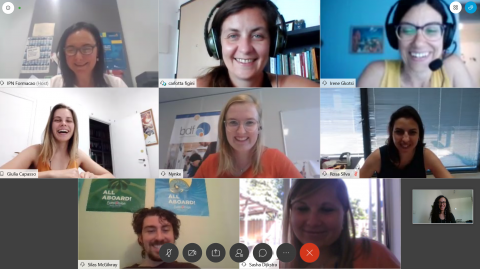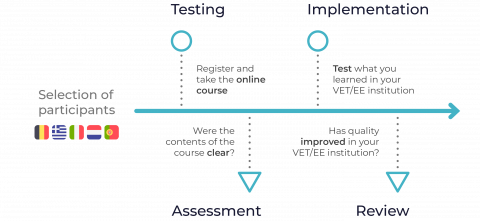1.4 - What should I do as a quality manager
Abstract
As Quality Manager, you should foster and raise awareness of the quality culture in the VET provider
and make it clear to your staff colleagues. You are responsible for the training policy and its general
management and coordination, ensuring:
- the planning, implementation, monitoring, control, and evaluation of the training plan;
- the management of training resources (check action card 3.1);
- the quality in the relationships with external stakeholders that affect the training plan;
- the articulation between trainers and trainees and other stakeholders involved (check action card 2.5);
- the promotion of review and continuous improvement actions and the implementation of training quality mechanisms (check action card 1.2);
- the integration of updated certification systems;
- the alignment between the formative practices implemented in the entity and the certification requirements
Why is this important for you as a QM?
- to understand your position in the organisation structure;
- to know the interlocutors / areas with which you relate to define competencies and performance indicators;
- to identify gaps in the curriculum as well as which training is most needed;
- to provide a set of resources essential for quality action at each stage of the training cycle and for the training areas concerned;
- to ensure that the planning of the training activity is based on the previously identified needs;
- to encourage results’ orientation and continuous improvement practices of the trainers;
- to look for practices that are more professional
Therefore, in order to achieve your goals, it is important for you to possess the following skills:
- Communication skills: These skills will help you impart information and training to audiences made up of different backgrounds and personalities
- Decision making skills: these can be valuable in determining successful training programs
- Leadership skills: most QM are in charge of staff engagement in a variety of responsibilities and duties. You will be able to motivate and teach them
- Collaboration skills: this is important once you are working with trainees, trainers, other management, and external stakeholders.
How should I implement the action?
You should work on several fronts to achieve success as a QM:
- Do a SWOT analysis (for understanding the needs & expectations of all the interested parties);
- Set VET centre’s goals and indicators in order to measure them;
- Agree on a vision/mission;
- Understand the staff’s training needs, in order to train and evaluate them (continuous improvement);
- Involve all relevant stakeholders;
- Monitor equipment reservation according to the organization’s needs;
- Evaluate suppliers and subcontractors annually;
- Keep a list of the evaluated ones;
- Measure clients’ satisfaction through questionnaires or other ways;
- Keep records of complaints and non-conformities and apply corrective actions;
- Monitor changes and opportunities for continual improvement;
- Evaluate annually or every semester all departments (Internal evaluation);
- Keep and update a general documentation of the whole quality management system
How should I know if I have made an impact thus increasing the quality of the VET provision and to which extent?
The following indicators should be in line with the vision/mission of the VET centre and in most cases
should be between 75-90%:
- % of projects on time, scope and budget;
- % of planning deadlines achieved;
- % of strategic risks mitigated;
- % of knowledge achieved with training;
- % of trainee and other staff satisfaction;
- % of personal development plans completed;
- % of skills development plans executed
The above-mentioned percentage of 75-90% does not apply to these two indicators:
8. % of personal tasks overdue
9. % of skills gap
Links & further readings
- Cedefop 2015, Handbook for VET providers [https://www.cedefop.europa.eu/files/3068_en.pdf]. Last accessed 15/04/2020
- European Training Foundation, 2015, PROMOTING QUALITY ASSURANCE IN VOCATIONAL EDUCATION AND TRAINING [https://www.etf.europa.eu/sites/default/files/m/B77049AC22B5B2E9C125820B006AF647_Promoting%20QA%20in%20VET.pdf] (Last accessed 15/04/2020)
- My Majors, “What skills are required for Computer and Information Systems Managers?” https://www.mymajors.com/career/quality-assurance-manager-qa-manager-/skills/ (Last accessed 30/04/2020)
- Adrie J. Visscher (Editor) ,(2009), “Improving Quality Assurance in European Vocational Education and Training: Factors Influencing the Use of Quality Assurance Findings 2009th Edition”, Springer, 192 pages, https://www.amazon.com/Improving-Assurance-European-Vocational-Education-dp-9048181496/dp/9048181496/ref=mt_paperback?_encoding=UTF8&me=&qid=1588600523



